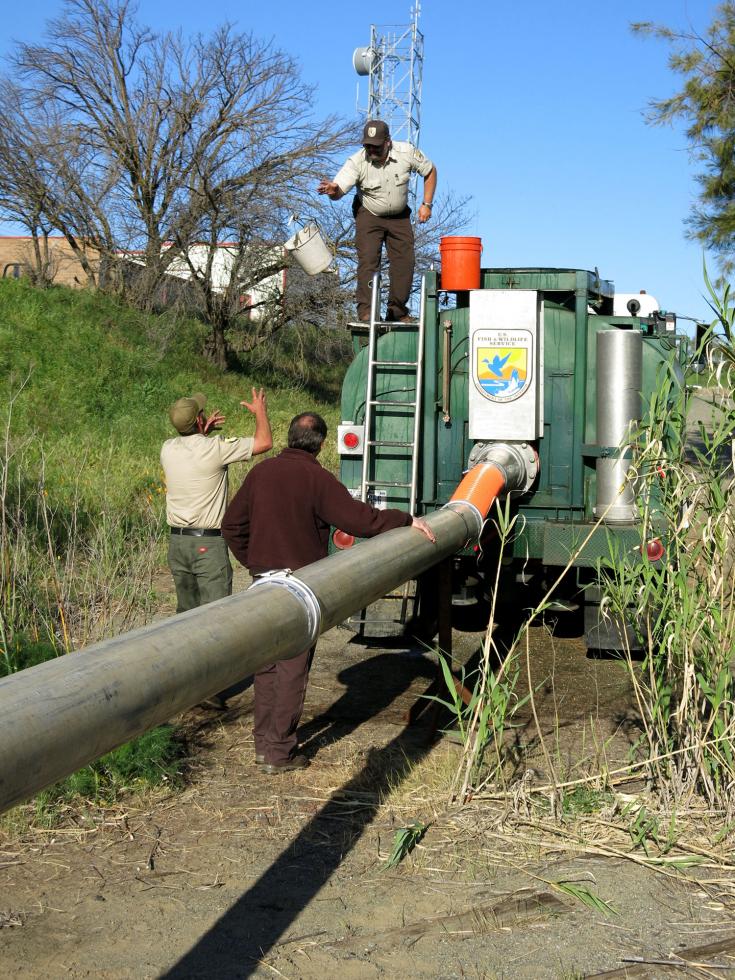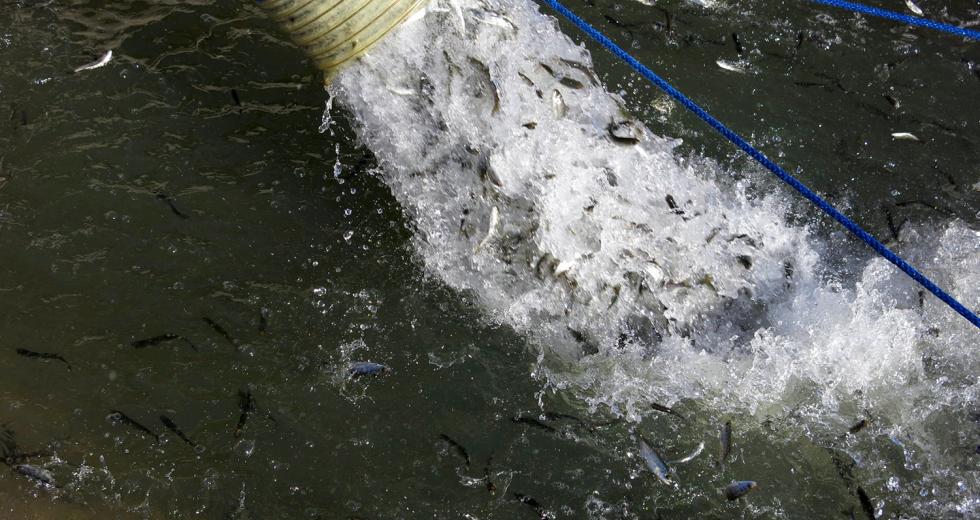In 2009, fewer fall-run Chinook salmon returned to spawn in the Central Valley than have ever been recorded before. Just 50,000 adult fish spawned that autumn in the entire Sacramento-San Joaquin river system — a tenth of how many Chinook migrate inland in a good year. The event was an ecological and economic disaster that prompted officials to shut down California’s ocean fishing season for two years.
What caused the collapse of the Central Valley fall-run — the core of the fishing industry — isn’t entirely clear. It has been alleged that pumping water from the Sacramento-San Joaquin Delta, mainly to support agriculture, caused the crash. In fact, just several years before the low return — when the 2009 spawning class would have been babies — the two major pumping stations near Tracy were pulling record-high volumes of water from the delta. The water pumps directly and indirectly kill small salmon and other fish while upsetting the natural flow patterns of the estuary.
But fish hatcheries may also have had something to do with the near disappearance of the most prized food fish in the state. Five Central Valley hatcheries produce tens of millions of Chinook every year, rearing them in tanks and releasing them into the wild when they are several inches long. In an era when natural spawning habitat for salmon has been widely eliminated, these facilities — managed by both the California Department of Fish and Wildlife and the U.S. Fish and Wildlife Service, have by and large kept salmon abundant in California and supported a strong fishing industry. This, in fact, is exactly why the hatcheries were built decades ago — to mitigate the dire consequences that new dams had on California’s naturally sustaining salmon runs.
But flaws in the way hatcheries operate have led to inbreeding, loss of genetic diversity and salmon that have become semi-domesticated animals and poorly fit to survive in the wild. The long-term results of this could be diminishing returns of the fish, even with hatchery support.
Salmon born in hatcheries are often especially vulnerable to environmental conditions. That’s partly because the hatcheries sometimes release many of their juvenile fish at one time, meaning the fish enter the ocean at once — hundreds of thousands of fingerlings blitzing out the Golden Gate together. The problem is, if the ocean isn’t ready to feed the fish, all may die. Jacob Katz, director of salmonid restoration initiatives with the group California Trout, suspects this happened in 2005 and 2006, when strong spring winds that generate ocean upwelling and phytoplankton production came later than usual. Three years later, biologists and fishermen saw a conspicuous generational gap in the fall-run Chinook.
“Mother Nature would have spread those fish out, so that some would have left on the early end, some in the middle and some at the end, like a stock portfolio that you spread across a wide range of investments,” Katz says. “The natural system had a far broader range of timing of fish leaving freshwater.”
(Photo courtesy of Alastair Bland)

Katz describes another problem created by hatchery operations: To insure they receive enough eggs each fall to meet their production goals, hatchery operators harvest and process a disproportionate number of early-arriving fish — fish swimming upriver in September and October. Because the time at which a salmon enters freshwater to spawn is genetically influenced, this practice has, over generations, created a slightly earlier-than-historic return schedule for the fish. This, says Katz, has made the salmon increasingly vulnerable to late-summer conditions that can destroy an entire year-class of fish, either by killing the temperature-sensitive eggs with lukewarm water or leaving the nests, dug into gravel beds, high and dry when upstream reservoirs begin running low.
In populations of naturally spawning salmon, fish enter the rivers over a wider range of time, with many fall-run fish in the Sacramento system laying and fertilizing eggs in late-November and December, when the river is usually cold and gushing with runoff. Katz says this makes naturally propagated populations resilient to hostile late-summer river conditions.
For more on the plight of Chinook salmon, check out Alastair Bland’s August feature, “Survival of the Fishes.”




Comments
This is not new information. Science has shown the negative impact hatcheries have had on wild fish for many years now. Wild animals are amazing beings. Reduce the hatchery programs and give the wild fish a chance.
All our wild spawning salmon have died last year and they will again die this year because the Bureau of Reclamation has diverted too much water already and didn't hold back enough cold water for the spawn. Reducing hatchery production will NOT give the wild fish a chance, it will only accelerate their decline.
"All" wild salmon did not die last year and "all" won't die this year. Wild salmon are more adapted to survival than hatchery salmon. The science is clear that hatchery fish negatively impact wild fish. The argument that reducing hatchery fish will accelerate the decline of wild fish makes no sense and is not supported by any facts.
Exactly right!
The science is indisputable that hatcheries are harming wild fish and recovery efforts. The current “well-intentioned” disaster in wild fisheries recovery is investment in unsustainable and non-volitional fish passage projects like trap and haul, barging, and potentially Gary Larsen style salmon cannons. These artificial money wasters don’t solve our fisheries crisis and make real recovery more difficult to achieve.
Due to the complexities of the hatchery/wild salmon issue, the media journalists seldom get it right. This article is one of those few exceptions that dug into the issue to actually evaluate the ways that hatcheries fail and how their results lead to further loss of wild salmon in their natural selection by the varied climatic conditions that have occurred the past 10s of thousands of years -- which included the Holocene warm period of 7,000-11,000 that was warmer than the present and which wild salmon survived through. Human alteration of the environment compounded by hatchery fish that are selected by further human interventions have resulted in fish that are out of sync with what climate and environmental change dictate. The resulting interactions of hatchery with wild fish have consistently eroded the ability of wild salmon to adapt as they must. This has been a consistent pattern up and down the West Coast and enumerated in dozens of peer-reviewed science findings all across the Northern Hemisphere in Eastern Canada and U.S., Europe, and Russia. The hatcheries, by the way, come at immense cost that is better spent on correcting the actual habitat problems that are wild salmon limitations. The public has, unfortunately, been fleeced in their funding of this immense hatchery failure that protecting habitat and wild salmon would have far better provided. No business person in their right mind would have continued to fund this monetary draining failure the past 130+ years that has only resulted in continually diminishing numbers of salmon. Thank you for the exceptional investigative article into this issue.